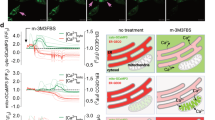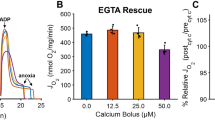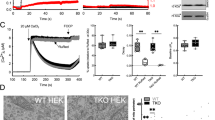Abstract
Mitochondrial cytochrome c release and inositol (1,4,5) trisphosphate receptor (InsP3R)-mediated calcium release from the endoplasmic reticulum mediate apoptosis in response to specific stimuli. Here we show that cytochrome c binds to the InsP3R during apoptosis. Addition of 1 nM cytochrome c blocks calcium-dependent inhibition of InsP3R function. Early in apoptosis, cytochrome c translocates to the endoplasmic reticulum where it selectively binds InsP3R, resulting in sustained, oscillatory cytosolic calcium increases. These calcium events are linked to the coordinate release of cytochrome c from all mitochondria. Our findings identify a feed-forward mechanism whereby early cytochrome c release increases InsP3R function, resulting in augmented cytochrome c release that amplifies the apoptotic signal.
This is a preview of subscription content, access via your institution
Access options
Subscribe to this journal
Receive 12 print issues and online access
$209.00 per year
only $17.42 per issue
Buy this article
- Purchase on SpringerLink
- Instant access to full article PDF
Prices may be subject to local taxes which are calculated during checkout








Similar content being viewed by others
References
Berridge, M.J., Lipp, P. & Bootman, M.D. The versatility and universality of calcium signalling. Nature Rev. Mol. Cell Biol. 1, 11–21 (2000).
Orrenius, S., Zhivotovsky, B. & Nicotera, P. Regulation of cell death: the calcium-apoptosis link. Nature Rev. Mol. Cell Biol. 4, 552–565 (2003).
Ferrari, D. et al. Endoplasmic reticulum, Bcl-2 and Ca(2+) handling in apoptosis. Cell Calcium 32, 413–420 (2002).
Hajnoczky, G., Csordas, G., Madesh, M. & Pacher, P. Control of apoptosis by IP(3) and ryanodine receptor driven calcium signals. Cell Calcium 28, 349–363 (2000).
Strasser, A., O'Connor, L. & Dixit, V.M. Apoptosis signaling. Annu. Rev. Biochem. 69, 217–245 (2000).
Goldstein, J.C., Waterhouse, N.J., Juin, P., Evan, G.I. & Green, D.R. The coordinate release of cytochrome c during apoptosis is rapid, complete and kinetically invariant. Nature Cell Biol. 2, 156–162 (2000).
Rizzuto, R. et al. Close contacts with the endoplasmic reticulum as determinants of mitochondrial Ca2+ responses. Science 280, 1763–1766 (1998).
Csordas, G., Thomas, A.P. & Hajnoczky, G. Quasi-synaptic calcium signal transmission between endoplasmic reticulum and mitochondria. EMBO J. 18, 96–108 (1999).
Bezprozvanny, I., Watras, J. & Ehrlich, B.E. Bell-shaped calcium-response curves of Ins(1,4,5)P3- and calcium-gated channels from endoplasmic reticulum of cerebellum. Nature 351, 751–754 (1991).
Finch, E.A., Turner, T.J. & Goldin, S.M. Calcium as a coagonist of inositol 1,4,5-trisphosphate-induced calcium release. Science 252, 443–446 (1991).
Boehning, D. & Joseph, S.K. Functional properties of recombinant type I and type III inositol 1, 4,5-trisphosphate receptor isoforms expressed in COS-7 cells. J. Biol. Chem. 275, 21492–21499 (2000).
Tenhunen, R., Marver, H.S. & Schmid, R. The enzymatic conversion of heme to bilirubin by microsomal heme oxygenase. Proc. Natl Acad. Sci. USA 61, 748–755 (1968).
Wojcikiewicz, R.J. Type I, II, and III inositol 1,4,5-trisphosphate receptors are unequally susceptible to down-regulation and are expressed in markedly different proportions in different cell types. J. Biol. Chem. 270, 11678–11683 (1995).
Diaz, F. & Bourguignon, L.Y. Selective down-regulation of IP(3)receptor subtypes by caspases and calpain during TNFα-induced apoptosis of human T-lymphoma cells. Cell Calcium 27, 315–328 (2000).
Hirota, J., Furuichi, T. & Mikoshiba, K. Inositol 1,4,5-trisphosphate receptor type 1 is a substrate for caspase-3 and is cleaved during apoptosis in a caspase-3-dependent manner. J. Biol. Chem. 274, 34433–34437 (1999).
Sugawara, H., Kurosaki, M., Takata, M. & Kurosaki, T. Genetic evidence for involvement of type 1, type 2 and type 3 inositol 1,4,5-trisphosphate receptors in signal transduction through the B-cell antigen receptor. EMBO J. 16, 3078–3088 (1997).
Ikonen, E., Fiedler, K., Parton, R.G. & Simons, K. Prohibitin, an antiproliferative protein, is localized to mitochondria. FEBS Lett. 358, 273–277 (1995).
Selvin, P.R. Fluorescence resonance energy transfer. Methods Enzymol. 246, 300–334 (1995).
Mochizuki, N. et al. Spatio-temporal images of growth-factor-induced activation of Ras and Rap1. Nature 411, 1065–1068 (2001).
Sorkin, A., McClure, M., Huang, F. & Carter, R. Interaction of EGF receptor and grb2 in living cells visualized by fluorescence resonance energy transfer (FRET) microscopy. Curr. Biol. 10, 1395–1398 (2000).
Hausmann, G. et al. Pro-apoptotic apoptosis protease-activating factor 1 (Apaf-1) has a cytoplasmic localization distinct from Bcl-2 or Bcl-x(L). J. Cell Biol. 149, 623–634 (2000).
Okazaki, M., Ishibashi, Y., Asoh, S. & Ohta, S. Overexpressed mitochondrial hinge protein, a cytochrome c-binding protein, accelerates apoptosis by enhancing the release of cytochrome c from mitochondria. Biochem. Biophys. Res. Commun. 243, 131–136 (1998).
Jayaraman, T. & Marks, A.R. T cells deficient in inositol 1,4,5-trisphosphate receptor are resistant to apoptosis. Mol. Cell Biol. 17, 3005–3012 (1997).
Blackshaw, S. et al. Type 3 inositol 1,4,5-trisphosphate receptor modulates cell death. FASEB J. 14, 1375–1379 (2000).
Khan, A.A. et al. Lymphocyte apoptosis: mediation by increased type 3 inositol 1,4,5-trisphosphate receptor. Science 273, 503–507 (1996).
Marsden, V.S. et al. Apoptosis initiated by Bcl-2-regulated caspase activation independently of the cytochrome c/Apaf-1/caspase-9 apoptosome. Nature 419, 634–637 (2002).
Lassus, P., Opitz-Araya, X. & Lazebnik, Y. Requirement for caspase-2 in stress-induced apoptosis before mitochondrial permeabilization. Science 297, 1352–1354 (2002).
Boehning, D. & Joseph, S.K. Direct association of ligand-binding and pore domains in homo- and heterotetrameric inositol 1,4,5-trisphosphate receptors. EMBO J. 19, 5450–5459 (2000).
Joseph, S.K. & Samanta, S. Detergent solubility of the inositol trisphosphate receptor in rat brain membranes. Evidence for association of the receptor with ankyrin.PG. J. Biol. Chem. 268, 6477–6486 (1993).
Dore, S. et al. Bilirubin, formed by activation of heme oxygenase-2, protects neurons against oxidative stress injury. Proc. Natl Acad. Sci. USA 96, 2445–2450 (1999).
Ferris, C.D., Cameron, A.M., Huganir, R.L. & Snyder, S.H. Quantal calcium release by purified reconstituted inositol 1,4,5- trisphosphate receptors. Nature 356, 350–352 (1992).
Venkatachalam, K., Ma, H.T., Ford, D.L. & Gill, D.L. Expression of functional receptor-coupled TRPC3 channels in DT40 triple receptor InsP3 knockout cells. J. Biol. Chem. 276, 33980–33985 (2001).
Acknowledgements
The authors thank D.B. Murphy for valuable comments and FRET instrumentation. We also thank S.K. Joseph for an initial supply of anti-InsP3R-I antibody and InsP3R expression constructs. We appreciate the support and useful discussion of D. Van Rossum, R.E. Rothe and P. Stankovic. This work was supported by USPHS grants MH-18501 and DA-000266 and Research Scientist Award DA-00074 (SHS), and National Research Service Awards NS-043850 (D.B.) and NH65090 (R.L.P.).
Author information
Authors and Affiliations
Corresponding author
Ethics declarations
Competing interests
The authors declare no competing financial interests.
Supplementary information
Supplementary Information, Fig. S1
Supplementary Information, Fig. S2 (PDF 82 kb)
Supplementary Information, Fig. S3
Supplementary Information, Fig. S4
Rights and permissions
About this article
Cite this article
Boehning, D., Patterson, R., Sedaghat, L. et al. Cytochrome c binds to inositol (1,4,5) trisphosphate receptors, amplifying calcium-dependent apoptosis. Nat Cell Biol 5, 1051–1061 (2003). https://doi.org/10.1038/ncb1063
Received:
Accepted:
Published:
Issue Date:
DOI: https://doi.org/10.1038/ncb1063
This article is cited by
-
Diverse functions of cytochrome c in cell death and disease
Cell Death & Differentiation (2024)
-
The potential role of hydrogen sulfide in cancer cell apoptosis
Cell Death Discovery (2024)
-
FAM83B regulates mitochondrial metabolism and anti-apoptotic activity in pulmonary adenocarcinoma
Apoptosis (2024)
-
Inositol 1,4,5-trisphosphate receptor type 1 autoantibody (ITPR1-IgG/anti-Sj)-associated autoimmune cerebellar ataxia, encephalitis and peripheral neuropathy: review of the literature
Journal of Neuroinflammation (2022)
-
TREX1 Deficiency Induces ER Stress-Mediated Neuronal Cell Death by Disrupting Ca2+ Homeostasis
Molecular Neurobiology (2022)



